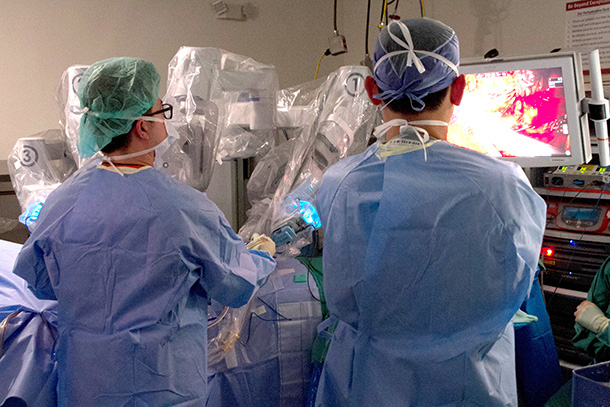To do what’s best for a patient, sometimes a combined effort is the best approach. That was the case recently at Keck Medical Center of USC, where an experienced neurosurgeon and an expert in robot-assisted urologic surgery teamed up successfully to remove a particularly troublesome spinal tumor.
Patrick C. Hsieh, MD, associate professor in the Department of Neurological Surgery and director of minimally invasive spine surgery at the Keck School of Medicine of USC, enlisted Andrew J. Hung, MD, assistant professor of clinical urology, to assist him during a paraspinal tumor resection on Nov. 3. The patient, a 71-year-old woman with neuromatosis, had developed a rapidly growing tumor outside the spinal canal, next to the aorta and kidneys in the L3-L4 spinal section.
“For this particular tumor in this location, we felt that this was a favorable tumor to treat robotically,” Hsieh said. “The advantage of the robotic procedure is that there is a much smaller incision with very little disruption of the soft tissue and minimal blood loss.”
The da Vinci Surgical System robot has brought revolutionary changes to certain major surgeries, particularly in urology. Other fields, including neurosurgery, may not yet have as much experience using the device, however, so a multidisciplinary approach is needed to provide the most meaningful benefits to a patient.
“Teamwork is critical between specialties and surgeons — each brings critical skills and experience in multidisciplinary procedures like this,” said Hung, who is director of robotic simulation and education at the USC Institute of Urology. “In this procedure, we incurred almost no blood loss, and the surgery was completed in a little over an hour. The neurosurgery team told us that a similar procedure done traditionally [non-robotically] could have taken several hours longer and resulted in significantly more blood loss.”
The surgeons approached the deep-seated spinal tumor through multiple small ports and, because of the robot’s ability to work in confined spaces, quickly were able to dissect the tumor from the nerves and organs before removing the mass. In this case, the patient has underlying health problems that delayed her release from the hospital, but Hsieh said healthier patients could be discharged as soon as the next day after a robotic procedure.
“We are developing innovative ways to deal with complex diseases and a multidisciplinary approach allows us to do things that each of us would not be able to do separately,” Hsieh said.
— Melissa Masatani


